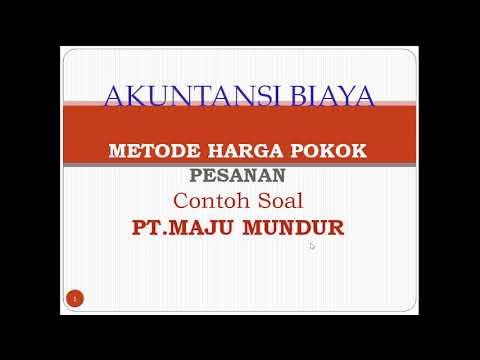Harga Pokok Pesanan dengan Variabel Costing
Summary
TLDRIn this video, the concept of variable costing is explained through a practical example of PTXY, a printing company using the job order costing method. The process covers the allocation of costs such as raw materials, direct labor, and overheads, breaking them into variable and fixed components. The video walks through how to record costs, calculate the cost of goods manufactured, and adjust for differences between applied and actual overhead. Key concepts such as direct labor, raw materials usage, and the treatment of manufacturing overhead are explored, along with journal entries for sales and cost recognition.
Takeaways
- 😀 Variable costing is applied in job order costing to allocate costs for specific job orders, such as orders 101, 102, 103, and 104.
- 😀 Costs are tracked individually for direct materials, direct labor, and variable overhead, with each job's costs clearly documented.
- 😀 For PTXY (the printing company), details about direct material, labor, and variable overhead are provided for January's operations.
- 😀 Variable manufacturing overhead is applied based on labor hours, with a rate of Rp500 per hour for job orders.
- 😀 The costs of materials used and labor hours worked are recorded for each job order, providing detailed insight into production expenses.
- 😀 Fixed and variable costs are differentiated to ensure that accurate accounting of overheads and materials is done for each job.
- 😀 When calculating the cost of goods sold (HPP), job-specific costs such as raw materials and labor are factored in based on the job orders.
- 😀 Overhead is calculated separately, and variances between applied and actual costs are addressed at the end of the accounting period.
- 😀 After calculating the total cost of the job, the goods are moved to 'finished goods' inventory, where further cost adjustments are made.
- 😀 Sales revenue is recorded separately, and the HPP for each job order is adjusted based on the final cost of production and sales price.
- 😀 Variances in overhead (over or under-applied) are adjusted at the end of the period to ensure accurate cost reporting for the business.
Q & A
What is the main focus of the discussion in this video?
-The main focus is on the application of variable costing in job-order costing, specifically how it is applied to the cost calculations of both job-order and process costing methods.
What is job-order costing, and how is it related to variable costing in this example?
-Job-order costing is a method used to assign costs to specific jobs or orders. In this example, variable costing is applied to job-order costing by categorizing certain costs, like materials and labor, as variable, while others, like overhead, are categorized as either variable or fixed.
What kind of company is PTXY in the example, and what costing method do they use?
-PTXY is a printing company that uses the job-order costing method with variable costing. This method tracks costs for individual orders (or jobs) and allocates both direct and indirect costs accordingly.
How are the variable costs related to the materials used in the example?
-Variable costs in this example are related to the direct materials used for each specific order. Only the direct materials are considered in the variable cost calculation, whereas other materials, like auxiliary materials, are treated as fixed costs.
What does the term 'BOP' refer to in this context, and how is it used?
-BOP stands for 'Biaya Overhead Pabrik' (Factory Overhead Costs). In the context of this example, BOP is divided into variable and fixed components, with variable BOP being allocated based on direct labor hours, while fixed BOP is treated as a separate fixed cost.
How are overhead costs allocated in this example?
-Overhead costs (BOP) are allocated based on direct labor hours. A rate of Rp500 per hour is used to allocate the variable overhead to each job order, and then fixed overhead costs are accounted for separately.
How is the total cost for each job calculated in the example?
-The total cost for each job is calculated by summing the direct material costs, direct labor costs, and allocated overhead costs (both variable and fixed). These costs are recorded and updated in the job cost card for each order.
What is the process for recognizing the costs associated with a finished job?
-Once a job is finished, the costs are moved from the 'work in process' account to the 'finished goods' account. This includes materials, labor, and overhead costs, which are credited to remove them from the work-in-process account.
What happens if there is a difference between the applied and actual overhead costs?
-If there is a difference between the applied (calculated based on labor hours) and actual overhead costs, the difference is recorded as either overapplied or underapplied overhead, and it is adjusted in the financial records accordingly.
How are the sales and cost of goods sold recorded in this example?
-Sales are recorded by crediting the sales account, and the cost of goods sold (COGS) is recorded by debiting the COGS account, which includes the cost of the goods that have been sold. This amount is based on the total costs incurred for the orders that have been completed and sold.
Outlines

This section is available to paid users only. Please upgrade to access this part.
Upgrade NowMindmap

This section is available to paid users only. Please upgrade to access this part.
Upgrade NowKeywords

This section is available to paid users only. Please upgrade to access this part.
Upgrade NowHighlights

This section is available to paid users only. Please upgrade to access this part.
Upgrade NowTranscripts

This section is available to paid users only. Please upgrade to access this part.
Upgrade Now5.0 / 5 (0 votes)





